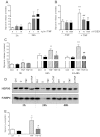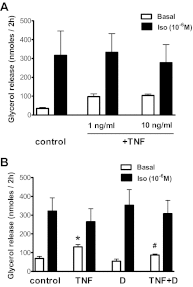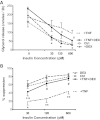Glucocorticoids antagonize tumor necrosis factor-α-stimulated lipolysis and resistance to the antilipolytic effect of insulin in human adipocytes
- PMID: 22949029
- PMCID: PMC3492859
- DOI: 10.1152/ajpendo.00228.2012
Glucocorticoids antagonize tumor necrosis factor-α-stimulated lipolysis and resistance to the antilipolytic effect of insulin in human adipocytes
Abstract
High concentrations of TNF within obese adipose tissue increase basal lipolysis and antagonize insulin signaling. Adipocytes of the obese are also exposed to elevated levels of glucocorticoids (GCs), which antagonize TNF actions in many cell types. We tested the hypothesis that TNF decreases sensitivity to the antilipolytic effect of insulin and that GCs antagonize this effect in differentiated human adipocytes. Lipolysis and expression levels of lipolytic proteins were measured after treating adipocytes with TNF, dexamethasone (DEX), or DEX + TNF for up to 48 h. TNF not only increased basal lipolysis, it caused resistance to the antilipolytic effects of insulin in human adipocytes. DEX alone did not significantly affect lipolysis. Cotreatment with DEX blocked TNF induction of basal lipolysis and insulin resistance by antagonizing TNF stimulation of PKA-mediated phosphorylation of hormone-sensitive lipase (HSL) at Ser⁵⁶³ and Ser⁶⁶⁰ and perilipin. TNF did not affect perilipin, HSL, or phosphodiesterase-3B mass but paradoxically suppressed adipose tissue triglyceride lipase expression, and this effect was blocked by DEX. The extent to which GCs can restrain the lipolytic actions of TNF may both diminish the potentially deleterious effects of excess lipolysis and contribute to fat accumulation in obesity.
Figures






Similar articles
-
Cardiotrophin-1 stimulates lipolysis through the regulation of main adipose tissue lipases.J Lipid Res. 2014 Dec;55(12):2634-43. doi: 10.1194/jlr.M055335. Epub 2014 Oct 28. J Lipid Res. 2014. PMID: 25351614 Free PMC article.
-
Pycnogenol supplementation promotes lipolysis via activation of cAMP-dependent PKA in ob/ob mice and primary-cultured adipocytes.J Nutr Sci Vitaminol (Tokyo). 2014;60(6):429-35. doi: 10.3177/jnsv.60.429. J Nutr Sci Vitaminol (Tokyo). 2014. PMID: 25866307
-
Stimulation of human omental adipose tissue lipolysis by growth hormone plus dexamethasone.Mol Cell Endocrinol. 2008 Nov 25;295(1-2):101-5. doi: 10.1016/j.mce.2008.05.014. Epub 2008 Jul 21. Mol Cell Endocrinol. 2008. PMID: 18640775
-
Molecular mechanisms regulating hormone-sensitive lipase and lipolysis.Biochem Soc Trans. 2003 Dec;31(Pt 6):1120-4. doi: 10.1042/bst0311120. Biochem Soc Trans. 2003. PMID: 14641008 Review.
-
Regulation of adipocyte lipolysis.Nutr Res Rev. 2014 Jun;27(1):63-93. doi: 10.1017/S095442241400002X. Epub 2014 May 28. Nutr Res Rev. 2014. PMID: 24872083 Review.
Cited by
-
Silencing Mediator of Retinoid and Thyroid Hormone Receptors (SMRT) regulates glucocorticoid action in adipocytes.Mol Cell Endocrinol. 2015 May 15;407:52-6. doi: 10.1016/j.mce.2015.03.002. Epub 2015 Mar 9. Mol Cell Endocrinol. 2015. PMID: 25766503 Free PMC article.
-
Low expression of the GILZ may contribute to adipose inflammation and altered adipokine production in human obesity.J Lipid Res. 2016 Jul;57(7):1256-63. doi: 10.1194/jlr.M067728. Epub 2016 May 13. J Lipid Res. 2016. PMID: 27178044 Free PMC article.
-
Loss of the TNFα function inhibits Wnt/β-catenin signaling, exacerbates obesity development in adolescent spontaneous obese mice.Mol Cell Biochem. 2014 Jun;391(1-2):59-66. doi: 10.1007/s11010-014-1987-5. Epub 2014 Feb 13. Mol Cell Biochem. 2014. PMID: 24522555 Free PMC article.
-
Acute Hypercortisolemia Exerts Depot-Specific Effects on Abdominal and Femoral Adipose Tissue Function.J Clin Endocrinol Metab. 2017 Apr 1;102(4):1091-1101. doi: 10.1210/jc.2016-3600. J Clin Endocrinol Metab. 2017. PMID: 28323916 Free PMC article. Clinical Trial.
-
Rosiglitazone remodels the lipid droplet and britens human visceral and subcutaneous adipocytes ex vivo.J Lipid Res. 2019 Apr;60(4):856-868. doi: 10.1194/jlr.M091173. Epub 2019 Feb 19. J Lipid Res. 2019. PMID: 30782959 Free PMC article.
References
-
- Borst SE. The role of TNF-alpha in insulin resistance. Endocrine 23: 177–182, 2004 - PubMed
-
- Campbell JE, Peckett AJ, D'souza A, Hawke TJ, Riddell MC. Adipogenic and lipolytic effects of chronic glucocorticoid exposure. Am J Physiol Cell Physiol 300: C198–C209, 2011 - PubMed
-
- Cao YL, Hu CZ, Meng X, Wang DF, Zhang J. Expression of TNF-alpha protein in omental and subcutaneous adipose tissue in obesity. Diabetes Res Clin Pract 79: 214–219, 2008 - PubMed
Publication types
MeSH terms
Substances
Grants and funding
LinkOut - more resources
Full Text Sources
Medical

